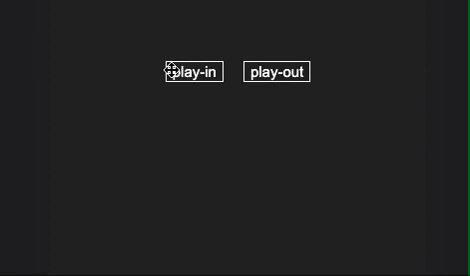Transitions manager
Transitions manager allows to handle and dispatch transition states from anywhere in the application.

Summary
Installation
npm i @cher-ami/transitions-manager
Life cycle
TransitionsManager allows to handle and dispatch two types of states:
- mountState
mount | unmount - playState
hidden | play-in | visible | play-out
The life cycle of a single transition order could be:
-
mount(mountState) -
play-in(playState) -
visible(playState) -
play-out(playState) -
hidden(playState) - default -
unmount(mountState) - default
It's possible to manage a transitions without using the mountState and only working with playState. The mountState is useful specificaly about the React usage.
Vanilla usage
Create a new instance to manager the transitions of your component:
export const componentTransitionsManager = new TransitionsManager()Listen mountState change:
const handleMountState = (mountState) => {
if (mountState === "mount") {
// do somthing and resolve mountState
componentTransitionsManager.mountComplete()
}
if (mountState === "unmount") {
// do somthing and resolve mountState
componentTransitionsManager.unmountComplete()
}
}
// start to listen
componentTransitionsManager.mountStateSignal.on(handleMountState)
// stop...
componentTransitionsManager.mountStateSignal.off(handleMountState)Listen playState change on the same way:
const handlePlayState = (playState) => {
if (playState === "play-in") {
// do something and resolve transition state
componentTransitionsManager.playInComplete()
}
if (playState === "play-out") {
// do something and resolve transition state
componentTransitionsManager.playOutComplete()
}
}
// start to listen
componentTransitionsManager.playStateSignal.on(handlePlayState)
// stop...
componentTransitionsManager.playStateSignal.off(handlePlayState)Now from anywhere, dispatch a new transition state with these methods
componentTransitionsManager.mount()
componentTransitionsManager.playIn()
componentTransitionsManager.playOut()
componentTransitionsManager.unmount()Options parameters
playIn and playOut methods accept options parameters.
componentTransitionsManager.playIn({ duration: 0 })From the components:
componentTransitionsManager.playStateSignal.on((playState, options) => {
console.log(options) // { duration: 0 }
})Default options can be set on the manager instance:
const componentTransitionsManager = new TransitionsManager({
options: {
duration: 1
}
})For typescript developers, GOption generic type is available on instance
const componentTransitionsManager = new TransitionsManager<{duration?: number}>({
options: {
duration: 1
}
})React usage
TransitionsManager is ready to use with vanilla javascript as above but it has been built for a React usage too. The API comes with hooks!
usePlayIn & usePlayOut
- Create a new transitionsManager instance as above
- Wrap your component by
TransitionsHoc(component, manager) - Then, define transitions in
usePlayInandusePlayOuthooks callback.
export const componentTransitionsManager = new TransitionsManager()function Component() {
usePlayIn(componentTransitionsManager, async (done, options) => {
await myPlayIn()
done()
})
usePlayOut(componentTransitionsManager, async (done, options) => {
await myPlayOut()
done()
})
return <div>...</div>
}
export default TransitionsHoc(Component, componentTransitionsManager)Now, from anywhere in the application, you can play the component via componentTransitionsManager his own transitionsManager instance.
await componentTransitionsManager.playIn()
// now, the transtion is done.componentTransitionsManager.playIn() will execute the transition function
of usePlayIn hook defined previously in Component. This method returns a
promise that will be resolved when the transition is done with done() function
from the same hook. Of course, "awaiting" the promise is not mandatory.
The TransitionsHoc function will mount and unmount automatically the component
before play out and after play out. It's possible to only play in and play out
without destroy the component with autoMountUnmount option:
const componentTransitionsManager = new TransitionsManager({ autoMountUnmount: false })useTransitionsManager
Instead of handle the transitionsManager playState with usePlayIn
and usePlayOut hooks, you can use the useTransitionsManager hook in your
component.
This one returns the current playState of the transitionsManager instance when
it changes. In this case, you have to execute the playInComplete
and playOutComplete functions when the transition is done.
useTransitionsManager(componentTransitionsManager, async (playState, options) => {
if (playState === "play-in") {
await myPlayIn()
componentTransitionsManager.playInComplete()
}
if (playState === "play-out") {
await myPlayOut()
componentTransitionsManager.playOutComplete()
}
})
// or get state from useTransitionsManager hook
const {playState, options} = useTransitionsManager(componentTransitionsManager)
// ...Mount and unmount manually (old API)
If TransitionsHoc wrapper is not used, the mount and unmount component state
can be managed manually. By using useIsMount hook from the parent component,
you can check the mount and unmount boolean state to condition the rendering.
const App = () => {
const mountComponent = useIsMount(componentTransitionsManager)
return <div>{mountComponent && <Component/>}</div>
}Now, you can mount and unmount the component.
playIn method will call mount methods before is execution, and playOut
will call unmount methods after is execution automatically.
await componentTransitionsManager.playIn() // auto mount + playIn
// ...
await componentTransitionsManager.playOut() // playOut + auto unmountIf the autoMountUnmount option is disable, you will have to mount and unmount
manually the component as below:
await componentTransitionsManager.mount()
await componentTransitionsManager.playIn()
// ...
await componentTransitionsManager.playOut()
await componentTransitionsManager.unmount()Debug
@wbe/debug is used on this project. It allows to easily get logs information on development and production modes.
- To use it, add this line in your browser console:
localStorage.debug = "TransitionsManager:*"
- Optionally, pass a name parameter to the instance to print it in the debug namespace.
const componentTransitionsManager = new TransitionsManager({name: "Component"})API
TransitionsManager constructor
{ name?: string, autoMountUnmount?: boolean, options?: Record<any, any> }
-
name(optional) used by debug as namespace -
autoMountUnmount(optional) playIn will auto mount, playOut will auto unmount - default is true -
options(optional) list of default playIn and playOut options
Mount
mount(): Promise<void>
mountComplete(): void
Unmount
unmount(): Promise<void>
unmountComplete(): void
PlayIn
playIn(options?: Partials<string, any>): Promise<void>
playInComplete(): void
PlayOut
playOut(options?: Partials<string, any>): Promise<void>
playOutComplete(): void
Utils
stagger(delay: number = 1, anims: (()=> any)[]): [promise: () => Promise<any>, cancel: () => void]
In some case, you want to execute a list of transitions in a staggered way.
Staggered transition can be setted with the util stagger function.
import {stagger} from "@cher-ami/transitions-manager"
const [start, clear] = stagger(0.1, [
componentTransitionsManager.playIn,
FooterTransitionsManager.playIn,
])
// start staggered transition
await start()
// clear staggered transition if needed
clear()Example
npm iStart dev server
npm run dev



